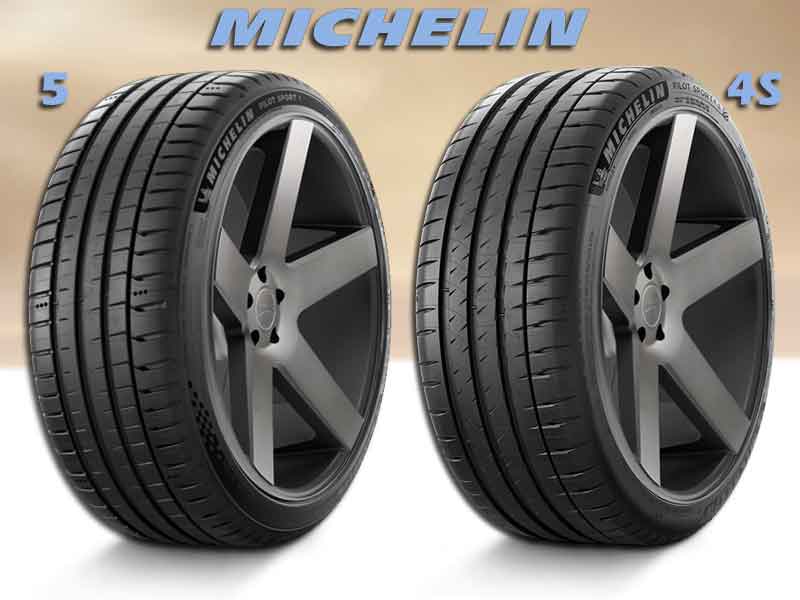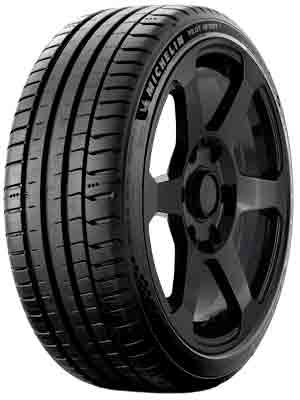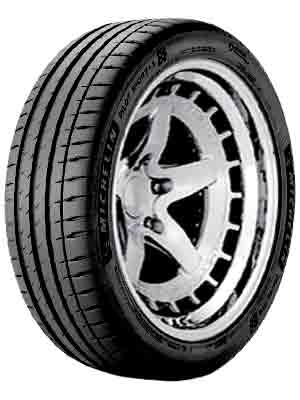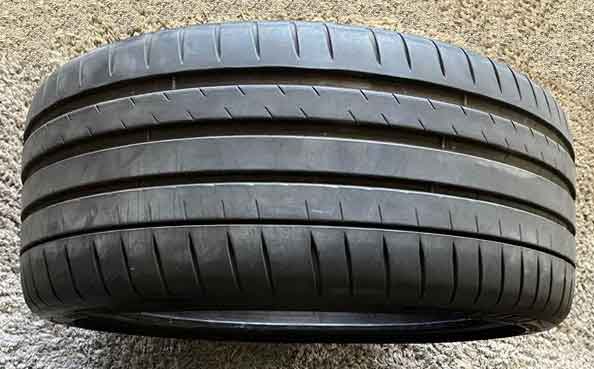These summer high performance tires are defined by their design. Their tread characterizes continuous ribs for firm road traction, making them suitable for high-speed driving. But is the new tire from Michelin even better?
Michelin Pilot Sport 5 offers better resistive features against hydroplaning and allows you to drive more safely in rainy weather. Along with that, it faces decreased road friction while rolling. It also comes with the financial benefits of fuel efficiency and lesser price.

We found almost the same results when we compared this tire with the New Continental Sportcontact 7.
Coming to the predecessor. The Michelin Pilot Sport 4S as we know is a max-performance tire that can also be used in sport cars due to its magnified traction abilities.
Dynamic response technology allows fully commanded steering response even when taking turns at high speed.
It offers more stable driving experiences and quieter rides than its competitor.
Heres the deal: Compared with Pilot Sport 5, Michelin 4S provides enhanced grip and more responsive handling on dry roads, higher ride comfort, and lower tire noise, but it also specifies relatively lesser fuel efficiency and higher price value.
- Michelin Pilot Sport 4 (Difference between 4 and 4S)
- Michelin Pilot Super Sport (Difference between 4 and SuperSport)
- Michelin Pilot Sport 3 (Difference with Pilot Sport 4)
Table of Contents
Michelin Pilot Sport 5 – Things you should know:
Michelin Pilot Sport 5

Michelin Pilot Sport 4s

The tread of Michelin Pilot Sport 5 is also asymmetrical having three uninterrupted ribs among four longitudinal grooves.

However, its grooves have increased depth and width, decreasing the contact patch of the tread.
Its siping pattern is denser and more prominent than the contestant; one of its ribs is marked by complete wide sipes while the other two specify smaller sipes upon half of their width.
Its shoulder blocks have bold, wide lateral voids, which are also connected with longitudinal channels.
Michelin Pilot Sport 4S – What you should know:

Michelin Pilot Sport 4S has an asymmetrically designed tread characterizing three continuous ribs and four circumferential grooves.
Its tread has slanted, crisp sipes on ribs’ edges and narrow cut-like lateral grooves within the shoulders.
It has a higher contact patch than the contestant because its grooves are relatively narrow and shallow.
Shoulder grooves on the outer side are connected with a circumferential groove, but lateral channels of the inner side are disconnected and separate.
Road Grip Comparison
| Pilot Sport 4S | Pilot Sport 5 | |
| Dry on-road Grip | High | Moderate |
| Wet on-road Grip | Moderate | High |
Michelin Sport 4S shows better performance on the dry pavement taking advantage of its large contact patch.
Its central ribs are wider, so the tread rolls forward with a strong grip over the road.
Textured edges of a marginal rib further increase its biting ability over the road.
Additionally, the outer half of the tire includes novel hybrid elastomers that provide increased dry grip.
However, when it comes to wet grip, it gets a lower score due to comparatively decreased hydroplaning resistivity.
Its smaller voids accommodate less water from the surface, so its tread shows a lesser wet grip than its competitor.
In contrast, Michelin Pilot Sport 5 stands below for its ability to grip the dry road because of its high void ratio.
Comparatively, a lesser surface area of its tread is in contact with the road, making its grip on the pavement less stable.
Nonetheless, when you take your vehicle over a wet road, its grip is comparatively firmer and more stable as it uses its deep channels and prominent sipes to wipe off the water standing on the road so that its tread can adhere to the ground properly.
Handling Comparison
| Pilot Sport 4S | Pilot Sport 5 | |
| Dry Handling | High | Moderate |
| Wet Handling | Moderate | High |
Both these tires are built according to the Dynamic Response technology, offering responsive and controlled steering.
However, they show different handling efficiencies depending upon their tread patterns.
While steering on the dry road, Pilot 4S takes the lead over its competitor because its shoulders are larger and have an increased ability to maintain firm traction when the vehicle turns along a corner.
Its bi-compound tread composition also helps in maintaining traction while taking turns.
But when you compare its handling performance on a wet track, it gets a lesser score due to the low void ratio of the tread.
As its hydroplaning resistance is comparatively minor, its traction while taking turns on a wet road is also reduced.
Conversely, Sport 5 performs relatively lower at corners on dry pavement because its larger lateral grooves have rendered its shoulder blocks smaller.
Yet its wet handling response is more commanded than its competitor because its large lateral channels do a good job wiping off water from the surface and sustaining the firm grip of tread on the road while the vehicle turns along.
Comparison of Hydroplaning Resistance
4S is more vulnerable to hydroplaning on a wet road due to the relatively lesser efficiency of its slip resistance features.
On one side, its tread channels are narrow and shallow, offering decreased water holding capacity, and on the other, its sipes are just like small crisp notches over the ribs having lesser whipping ability.
Likewise, shoulder grooves of only one side are connected with longitudinal grooves, which also decreases the water removal from tread channels.
Conversely, Pilot 5 presents higher resistance to aquaplaning on wet pavements because of its high void ratio and prominent siping pattern.
Water is efficiently thrown away from tread through its deep channels.
Besides that, its bold sipes also assist grooves in wiping water off the paved surface.
Another reason for quick water removal through its tread is that its longitudinal and lateral channels are interconnected on both sides.
Comparison of Rolling Resistance
Sport 5 has the advantage of fuel efficiency because it needs to overcome lesser rolling resistance due to a high void ratio.
When a lesser surface area of tread makes contact with the road, minimal friction arises, and much energy is used in overcoming hysteresis.
Thus, it can roll over the road comparatively easily, using only a small amount of fuel.
Pilot 4S is less fuel-efficient in comparison because its tread has a larger contact patch.
Thus, it has to overcome a bulk of rolling friction and requires relatively more energy to roll over the surface.
That is why it consumes more fuel than its competitor.
Comparison of Noise and comfort
| Pilot Sport 4S | Pilot Sport 5 | |
| Driving comfort | High | Moderate |
| Noise level | 71 dB | 72 dB |
Road rides on Sport 4S are more comfortable than its competitor because it offers higher driving stability and decreased rolling noise.
It offers maximized on-road traction abilities due to the bulky contact patch of the tread.
Likewise, it specifies minimized sound production as its grooves provide smaller space for movement and resonation of noise-producing particles.
Its noise level is recorded at 71dB on the decibel scale.
Michelin Sport 5 stands below when the comparison is about ride comfort because its tread having a minimized contact patch provides lesser dry traction.
Resultantly, its driving comfort is also decreased.
Moreover, sound waves get free space to resonate in its deep and wide tread channels, producing a lot of rolling noise.
It has reported a higher sound level specifying up to 72 decibels.
Durability and treadwear
These tires are equally durable summer tires that give a long-lasting performance for many years due to their sturdy composition and advanced technologies used in their construction.
Michelin uses the MaxTouch construction mechanism for their production, which provides enhanced tread life.
Their tread pattern features Le Mans-derived composition using two different polymers side-by-side;
- The outer side is molded from novel hybrid elastomers for enhanced dry grip.
- The inner side contains functional elastomers and silica enhancements for improving wet grip.
The internal structure is built by twin belts of steel alloy and reinforced by a spirally wounded hybrid of Aramid and nylon belt for providing Dynamic steering responses.
Over this, a single ply of polyester cord casing is applied and tuned to balance tension in the tread.
Likewise, Pilot Sport tires have velvet-effect checkered sidewalls constructed with a Cutting-edge mechanism and Premium Touch treatments.
Both have a 6-year treadwear warranty from the manufacturer.
However, by analyzing their tread patterns, we can say that Michelin Sport 5 will last longer than its competitor because it encounters lesser rolling resistance.
Hence, its tread will be consumed relatively slowly against road friction.
| Pilot Sport 4S | Pilot Sport 5 | |
| Tread composition | Le Mans-derived bi-compound tread; Hybrid elastomer compound, Silica elastomer compound | Le Mans-derived bi-compound tread; Hybrid elastomer compound, Silica elastomer compound |
| Rim Carcass | Two steel belts | Two steel belts |
| Treadwear warranty | 6 years | 6 years |
| Uniformity warranty | first 2/32’’ 1 year | first 2/32’’ 1 year |
| Workmanship warranty | 6 years | 6 years |
Quick Summary
Both of these are designated summer tires; Sport 4S is a Max Performance while Sport 5 is a usual passenger car tire.
Michelin Pilot Sport 4S…
- Shows better dry grip.
- Presents superior handling performance on the dry road.
- Makes lesser rolling noise than its competitor.
Pilot Sport 5…
- Provides enhanced performance on wet tracks.
- Offers higher hydroplaning resistivity.
- Consumes a lesser amount of fuel.


